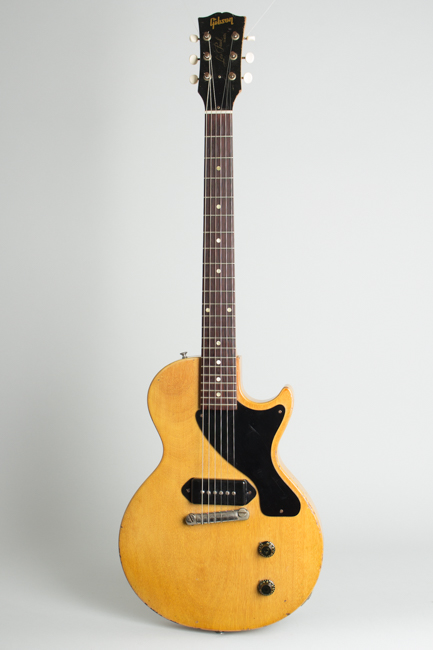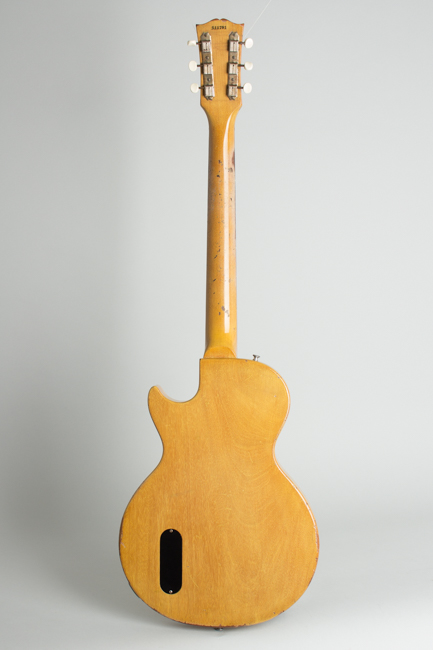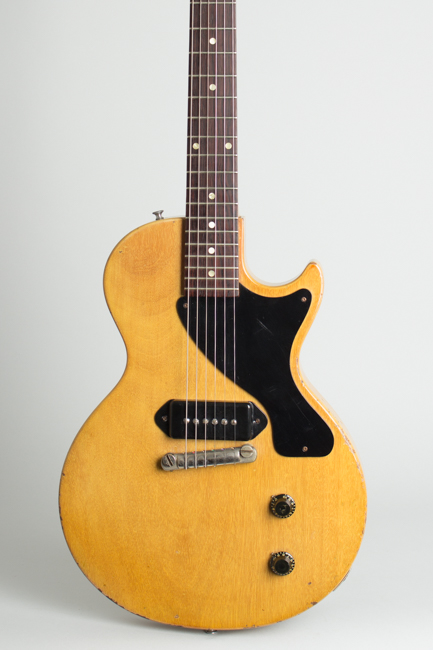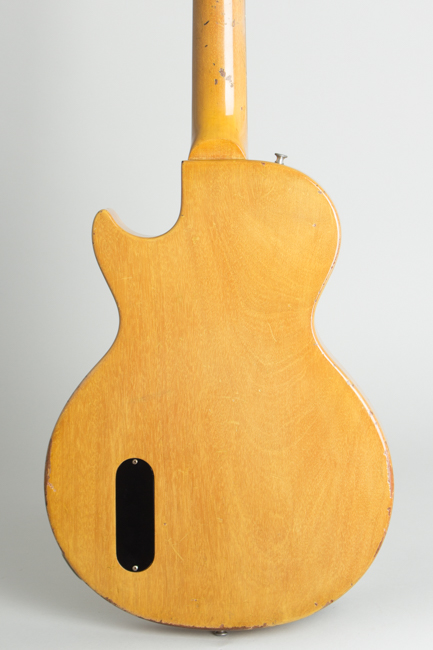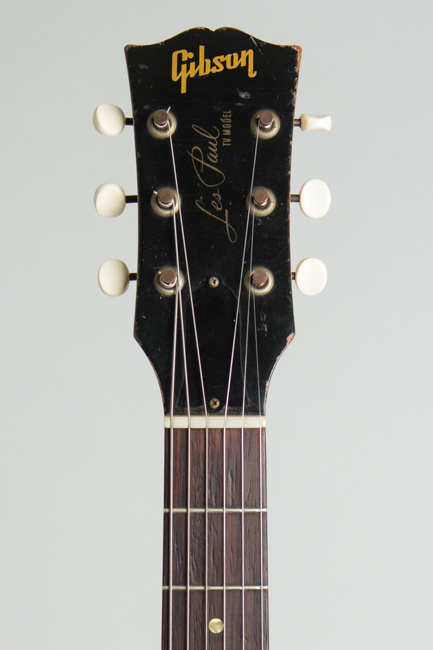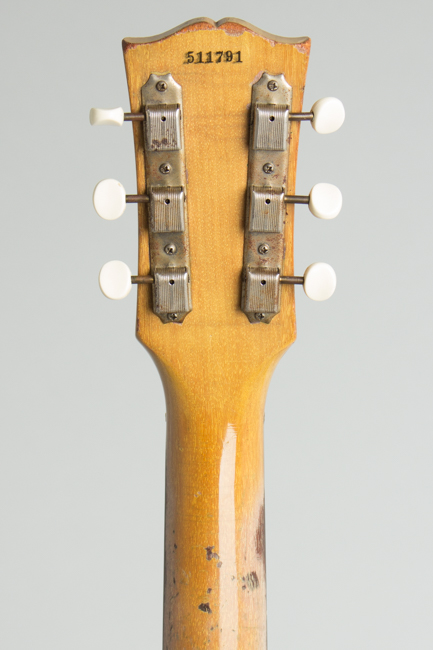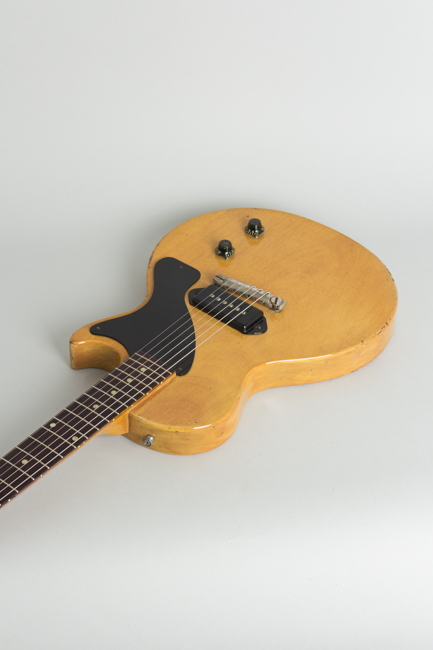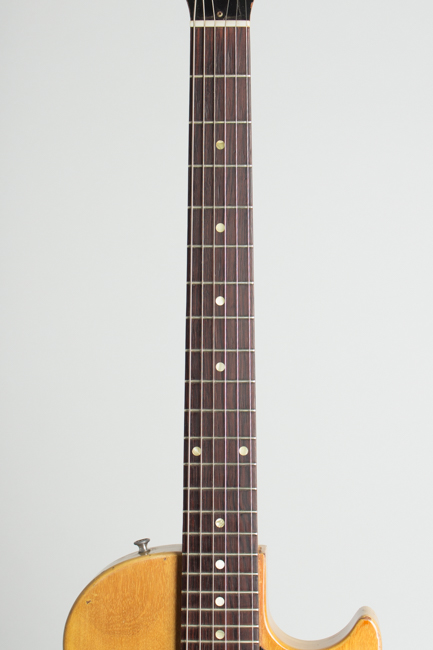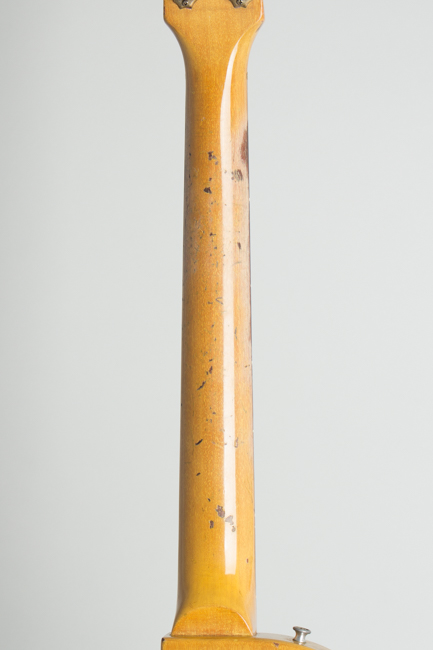Gibson Les Paul TV Junior Solid Body Electric Guitar (1955)
This item has been sold.
Item # 8999
Prices subject to change without notice.
Gibson Les Paul TV Junior Model Solid Body Electric Guitar (1955), made in Kalamazoo, Michigan, serial # 511791, limed mahogany finish, mahogany body and neck, rosewood fingerboard, black hard shell case.
This is a great-sounding if not absolutely original example of a 1955 Les Paul "TV Model", a variation on the classic '50s solid-body LP Junior. It features a fairly lightweight (just under 7.5 LBs) mahogany body and a single, very punchy P-90 pickup. This guitar has had some overspray to the original finish but other than that is substantially original.
The "TV" is structurally the same as the Les Paul Junior, distinguished by a lighter "limed mahogany" finish on the body and neck instead of a dark sunburst and a "Les Paul TV Model" silkscreen on the headstock. This variant is quite a bit rarer than the standard sunburst version -- only 230 TV Models shipped in 1955 compared to over 2800 of the standard sunburst Juniors.
The "TV" designation supposedly refers to the increased visibility the light-finished guitar would offer on the flickering monochrome sets of the day. It seems a bit odd though, as this was marketed as a student model. Who might actually be seen playing it on television is an open question; maybe on the Major Bowes Amateur Hour?
The neck on this one has a typical round-backed '50s profile, a bit slimmer and shallower than the later '50s models tend to be. The P-90 pickup is mounted under the "dogear" plastic cover close to the strings, giving it a very powerful output. The wiring rig is untouched, topped off with the black numbered knobs typical of the late '50s. The tuners are strip Kluson Deluxes, and the designation "Les Paul TV Model" is stenciled on the headstock under the Gibson logo.
As the name implies, the Junior was the most basic of Gibson's 1950s Les Paul line, with a single pickup, tone, and volume knobs, and simple bar bridge/tailpiece. This lack of complexity has stood it in good stead in the 1950s and beyond. While designed as a student guitar, the Junior has become justly renowned as one of the crunchiest and most powerful of straight rock guitars, with fantastic natural overdrive capabilities when paired with the right amp. The combination of the solid, thick mahogany body and neck with the single solidly mounted P-90 and bar bridge maximizes tonal response.
Many players prefer this model to all others for both crunch rhythm and searing lead. From Leslie West to Mick Ralphs, and Johnny Thunders to Paul Westerberg to Billie Joe Armstrong, Gibson's original 1950s Les Paul Junior and TV models has proven itself over and over to be the most basic of rock machines, as simple and effective as they come.
Overall length is 39 in. (99.1 cm.), 13 in. (33 cm.) wide at lower bout, and 1 11/16 in. (4.3 cm.) in depth, measured at side of rim. Scale length is 24 3/4 in. (629 mm.). Width of nut is 1 11/16 in. (43 mm.).
This "TV" is in excellent playing condition with all original hardware but has had some finish work over the years. It has not been re-finished, but the original "limed mahogany" lacquer looks to have been buffed out and a clear overspray added. The original yellowish pore filler and finish are still there, but with some of the surface buffed down, giving the guitar a more amber hue with a lot of grain showing through. A thin clear lacquer overcoat was then added over the remaining original "TV" finish. The face of the headstock was not sprayed over and remains original.
This work must have been done decades ago, as the guitar has accumulated a decent amount of wear since with dings, dents, and some light checking. The original tuners have newer buttons, but the pickup, electronics, pickguard, and bridge/tailpiece are all unaltered with some typical wear. The original serial number on the back of the headstock was stamped over with the same digits when the overspray was done, and the shadow can be seen beneath the redone numbers. The frets appear original and show some wear in the lower positions but still play well. This guitar has the expected rip-roaring sound and is an excellent playable relic with a cool and fairly unique "ragged but right" look. Very Good + Condition.
This is a great-sounding if not absolutely original example of a 1955 Les Paul "TV Model", a variation on the classic '50s solid-body LP Junior. It features a fairly lightweight (just under 7.5 LBs) mahogany body and a single, very punchy P-90 pickup. This guitar has had some overspray to the original finish but other than that is substantially original.
The "TV" is structurally the same as the Les Paul Junior, distinguished by a lighter "limed mahogany" finish on the body and neck instead of a dark sunburst and a "Les Paul TV Model" silkscreen on the headstock. This variant is quite a bit rarer than the standard sunburst version -- only 230 TV Models shipped in 1955 compared to over 2800 of the standard sunburst Juniors.
The "TV" designation supposedly refers to the increased visibility the light-finished guitar would offer on the flickering monochrome sets of the day. It seems a bit odd though, as this was marketed as a student model. Who might actually be seen playing it on television is an open question; maybe on the Major Bowes Amateur Hour?
The neck on this one has a typical round-backed '50s profile, a bit slimmer and shallower than the later '50s models tend to be. The P-90 pickup is mounted under the "dogear" plastic cover close to the strings, giving it a very powerful output. The wiring rig is untouched, topped off with the black numbered knobs typical of the late '50s. The tuners are strip Kluson Deluxes, and the designation "Les Paul TV Model" is stenciled on the headstock under the Gibson logo.
As the name implies, the Junior was the most basic of Gibson's 1950s Les Paul line, with a single pickup, tone, and volume knobs, and simple bar bridge/tailpiece. This lack of complexity has stood it in good stead in the 1950s and beyond. While designed as a student guitar, the Junior has become justly renowned as one of the crunchiest and most powerful of straight rock guitars, with fantastic natural overdrive capabilities when paired with the right amp. The combination of the solid, thick mahogany body and neck with the single solidly mounted P-90 and bar bridge maximizes tonal response.
Many players prefer this model to all others for both crunch rhythm and searing lead. From Leslie West to Mick Ralphs, and Johnny Thunders to Paul Westerberg to Billie Joe Armstrong, Gibson's original 1950s Les Paul Junior and TV models has proven itself over and over to be the most basic of rock machines, as simple and effective as they come.
Overall length is 39 in. (99.1 cm.), 13 in. (33 cm.) wide at lower bout, and 1 11/16 in. (4.3 cm.) in depth, measured at side of rim. Scale length is 24 3/4 in. (629 mm.). Width of nut is 1 11/16 in. (43 mm.).
This "TV" is in excellent playing condition with all original hardware but has had some finish work over the years. It has not been re-finished, but the original "limed mahogany" lacquer looks to have been buffed out and a clear overspray added. The original yellowish pore filler and finish are still there, but with some of the surface buffed down, giving the guitar a more amber hue with a lot of grain showing through. A thin clear lacquer overcoat was then added over the remaining original "TV" finish. The face of the headstock was not sprayed over and remains original.
This work must have been done decades ago, as the guitar has accumulated a decent amount of wear since with dings, dents, and some light checking. The original tuners have newer buttons, but the pickup, electronics, pickguard, and bridge/tailpiece are all unaltered with some typical wear. The original serial number on the back of the headstock was stamped over with the same digits when the overspray was done, and the shadow can be seen beneath the redone numbers. The frets appear original and show some wear in the lower positions but still play well. This guitar has the expected rip-roaring sound and is an excellent playable relic with a cool and fairly unique "ragged but right" look. Very Good + Condition.
